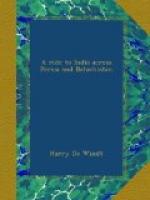[Illustration: A FAMILY PARTY]
As in many Eastern countries, a man is never allowed to die in peace in Persia. It is a ceremony like marriage or burial, and as soon as the doctors have pronounced a case hopeless, the friends and relations of the sick man crowd into his chamber and make themselves thoroughly at home, drinking tea and sherbet, and watching, through the smoke of many hubble-bubbles, the dying agonies of their friend. The wife of the dying man sits at his side, occasionally holding to the nostrils the Persian substitute for smelling-salts, i. e. a piece of mud torn from the wall of the dwelling and moistened with cold water. As a last resource, a fowl is often killed and placed, warm and bleeding, on the patient’s feet. This being of no avail, and death having taken place, the wife is led from the apartment, and the preparations for interment are commenced. Wet cotton-wool is stuffed into the mouth, nose, and ears of the corpse, while all present witness aloud that the dead man was a good and true Mohammedan. The body is laid out, a cup of water is placed at its head, and a moollah, ascending to the roof of the house, reads in a shrill nasal tone verses from the Koran. The professional mourners then arrive, and night or day is made hideous with their cries, while the “washers of the dead” proceed with their work. The coffin, [I] in Persia, is made of very thin wood; in the case of a poor man it is often dispensed with altogether, the corpse being buried in a shroud. Interment in most cases takes place forty-eight hours at most after death.
We found the house of Mr. P—, the Telegraph Superintendent of the Indo-European Company, with some difficulty, for the roads or rather lanes of Djulfa are tortuous and confusing. Mr. P—was out, but had left ample directions for our entertainment. A refreshing tub, followed by a delicious curry, washed down with iced pale ale, prepared one for the good cigar and siesta that followed, though an unlimited supply of English newspapers, the Times, Truth, and Punch, kept me well awake till the return of my host at sunset.
[Footnote A: A farsakh is about four miles.]
[Footnote B: “Hurrah!”]
[Footnote C: “Please God!”]
[Footnote D: Koom signifies “sand.”]
[Footnote E: Muleteer.]
[Footnote F: Kashan silk, noted throughout Persia, is of two kinds: the one thin and light for lining garments, the other thick and heavy for divans, etc. The patterns are generally white, yellow, and green on a red ground.]
[Footnote G: A natural sweetmeat like nougat, found and manufactured in Persia.]
[Footnote H: Attendant.]
[Footnote I: In the north of Persia the dead are buried in a shroud of dark-blue cloth, which is, oddly enough, called in the Persian language, a kaffin.]




